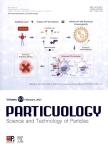CFD-DEM simulation of the hole cleaning process in a deviated well drilling: The effects of particle shape
CFD-DEM simulation of the hole cleaning process in a deviated well drilling: The effects of particle shape作者机构:Department of Mechanical Engineering Sharif University of Technology Azadi Avenue Tehran Iran School of Mechanical Engineering lran University of Science and Technology Narmak Tehran Iran
出 版 物:《Particuology》 (颗粒学报(英文版))
年 卷 期:2016年第14卷第2期
页 面:72-82页
核心收录:
学科分类:080704[工学-流体机械及工程] 08[工学] 0807[工学-动力工程及工程热物理] 0805[工学-材料科学与工程(可授工学、理学学位)] 080502[工学-材料学]
主 题:CFD DEM method Deviated well drilling Particles transport Two way coupling scheme Particle fluid Interaction
摘 要:We investigate the effect of particle shape on the transportation mechanism in well-drilling using a three-dimensional model that couples computational fluid dynamics (CFD) with the discrete element method (DEM). This numerical method allows us to incorporate the fluid-particle interactions (drag force, contact force, Saffman lift force, Magnus lift force, buoyancy force) using momentum exchange and the non-Newtonian behavior of the fluid. The interactions of particle-particle, particle-wall, and particle-drill pipe are taken into account with the Hertz-Mindlin model. We compare the transport of spheres with non-spherical particles (non-smooth sphere, disc, and cubic) constructed via the multi- sphere method for a range of fluid inlet velocities and drill pipe inclination angles. The simulations are carried out for laboratory-scale drilling configurations. Our results demonstrate good agreement with published experimental data. We evaluate the fluid-particle flow patterns, the particle velocities, and the particle concentration profiles. The results reveal that particle sphericity plays a major role in the fluid-solid interaction. The traditional assumption of an ideal spherical particle may cause inaccurate results.




